DOI: https://doi.org/10.56669/GQOK7318
ABSTRACT
We developed Bacillus biofertilizer “Kikuichi” for paddy rice. This biofertilizer is a granule type, and spores of Bacillus pumilus TUAT1 are absorbed by the granule having base material of zeolite. Size of granule is around 3 mm and 107 spores are kept in one gram of granules. Quality of this biofertilizer can keep at least 1 year at room temperature. When Bacillus biofertilizer “Kikuichi” is applied to rice seeds in nursery boxes, the seedlings show over 30% of increase of root growth such as root number and root weight of rice seedlings against the control plants without “Kikuichi.” When the rice plants with “Kikuichi” are transplanted to paddy fields, root growths are keeping in paddy field and promote nitrogen fertilizer uptake. These inoculation effects induce an increase of tillers of treated rice plants, therefore, application of “Kikuichi” increase yields of brown rice at 10 to 30%. Rice plants applied with “Kikuichi” promote the efficiency of fertilizer utilization to develop root systems, therefore this property directly connects to reducing amounts of fertilizer application.
Keywords: Bacillus biofertilizer “Kikuichi”, Paddy rice, Bacillus pumilus TUAT1, Root growth promotion, Yield increase, Efficient fertilizer utilization
INTRODUCTION
There has been a history of research on nitrogen-fixing bacteria that provide nitrogen nutrients or growth-promoting effects for plants in loose symbiosis in the rhizosphere of rice and other crops. In 1971, Yoshida et al., (1971) reported the discovery of nitrogen-fixing activity in the rice rhizosphere. Watanabe and Furusaka (1980) also revealed that many nitrogen-fixing bacteria live in the rice rhizosphere. In addition, Baldani and Dobereiner (1980) and Ladha et al., (1982) isolated Azospirillum lipoferum and A. brasilense from rice roots. Greenland and Watanabe (1982) estimated biological nitrogen fixation in paddy fields to be 50-75 Kg N/ha based on the nitrogen balance of paddy fields in Japan and the Philippines with long-term fertilizer use.
Based on those studies, agricultural researchers in Southeast Asia inoculated rice plants with bacteria such as Azospirillum and conducted numerous field tests to determine whether the effect of the nitrogen-fixing activity could reduce the amount of chemical nitrogen fertilizer commonly used. (FNCA Biofertilizer Project, Choudhury I. R. Kennedy 2004). Figure 1 shows the growth of rice inoculated/uninoculated with Azospirillum. After about one month, the growth of rice in the inoculated plot has been promoted compared to the uninoculated one.
In Japan, biofertilizers contain root nodule bacteria and mycorrhizal fungi, as shown in Figure 2. Asian countries are conducting researches on using various soil microorganisms as biofertilizers. Biofertilizers have not been found in Japan include technology to inoculate rice, sugarcane, corn, etc. with non-symbiotic nitrogen-fixing bacteria to supply nitrogen nutrients, or phosphorus and to inoculate vegetables with potassium solubilizing bacteria to supply phosphorus and potassium. Figure 3 shows the Azospirillum biofertilizer for paddy rice used in Thailand and the liquid biofertilizer in Malaysia containing phosphorus-solubilizing and potassium-solubilizing bacteria launched in 2014.

However, these biofertilizers contain living microorganisms, and the number of active microorganisms in the material decreases due to temperature and drought stresses. This is a serious problem because the quality of the product cannot be guaranteed. Therefore, we focused on spore-forming nitrogen-fixing microorganisms. Furthermore, we took on the challenge of developing a completely new biofertilizer for paddy rice, which does not exist in the world market until now, with the same ease of use as chemical fertilizers, which means the quality of the product will last for at least one year.

DEVELOPMENT OF BACILLUS BIOFERTILIZER "KIKUICHI"
In Japan, the research and development of biofertilizers for paddy rice with the aim of reducing the amounts of chemical fertilizers applied has hardly been carried out. There are many inoculation tests using Azospirillum bacteria in the world. However, quality control of Azospirillum bacteria is very difficult. On the other hand, there is no research on inoculants for paddy rice using bacteria of the genus Bacillus. In addition, Bacillus bacteria form spores and have high survivability even in high temperature and drought stress environments during both transportation and storage of biofertilizers.
Therefore, Bacillus pumilus TUAT1 strain was isolated from the field soil of Tokyo University of Agriculture and Technology (TUAT). It has been found that this strain has nitrogen-fixing ability and promotes rooting of rice. Figure 4 shows a photograph of colonies of Bacillus pumilus TUAT1 strain on TY medium.
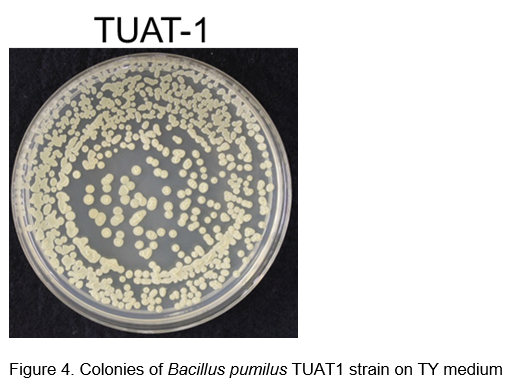
(i) Growth promoting effect of rice inoculated with TUAT1 strain (Evaluation tests in greenhouses and fields)
A pot test was started in 2008. We started testing the TUAT1 strain without knowing the optimal inoculation method. Therefore, the TUAT1 strain was cultured, the bacteria were collected with a centrifuge, and then mixed with steam sterilized Kuroboku soil from the Fuchu farm of TUAT. Bacteria density was set to 107 to 108 cells per gram of soil. The rice cultivar Leaf Star was used, and the test plots were conventionally fertilized plots (NPK 5kg/10a each), plots with 60% less nitrogen fertilizer applied, and non-fertilization plots, each of which was inoculated and non-inoculated. Inoculation was carried out by wrapping the roots at the time of transplantation with 200 g of the above inoculum. The measured items were the dry weight of each part, the accumulation of N, P, and K in the plant body, and the contribution rate of nitrogen fixation by the TUAT1 strain, which was estimated by the 15N natural abundance method.
The dry matter weight of the roots in inoculated plots of the conventional fertilization plots was about twice that of non-inoculated plots, indicating that inoculation greatly accelerates the development of roots. In addition, the accumulation of NPK in inoculated plots were promoted more compared with non-inoculated ones. Root development in the 60% reduced fertilizer plot was greater than that of non-inoculated conventional plot (data not shown).
Since the pot test in 2008 has clearly shown the inoculation effect of TUAT1 strain, a field test was conducted in 2009 in the Field Museum Honmachi paddy field (gravely ordinary gray lowland soil) of the Field Science Center in TUAT. As in 2008, 'Leaf Star' was used for rice cultivar. The test plots were a conventional fertilization plot (NPK10kg/10a), a 30% nitrogen fertilizer reduction plot, and a non-fertilization plot, and a bacteria inoculation plot and a non-inoculation plot were established for each. As for the bacterial inoculation method, 100 g of the above inoculum was suspended in water, and the roots at the time of transplanting were soaked about 15 minutes for inoculation. The measurement items were the dry weight of above-ground parts, the accumulation of N, P, and K in the plant body, and the 15N natural abundance method.
In the conventionally fertilized plot, the total dry matter weight of the inoculated plot increased by about 21% compared to the non-inoculated plot. Nitrogen accumulation in the inoculated plot of the conventional fertilization plot increased by 37% compared to the non-inoculated plot, and P and K accumulation also increased by 29%, respectively. On the other hand, in the 30% nitrogen-reduced plot, the total dry weight of the inoculated plot was 92% of that of the conventional non-inoculated plot. In addition, in the conventional fertilization plot and the 30% nitrogen fertilizer reduction plot, nutrient absorption and growth were clearly promoted in the inoculated plot compared to the non-inoculated plot (data not shown).
The results of 2008 pot experiments and 2009 field experiments showed that inoculation with the Bacillus biofertilizer increased dry matter accumulation and NPK accumulation in Leaf Star. In addition, it was presumed that the enhancement of nitrogen uptake in rice was due to the development of the root system by bacterial inoculation, which efficiently absorbed mineralized nitrogen in the soil and fertilized nitrogen. In the field test, about 30% of nitrogen reduction treatment with biofertilizer was observed to promote rice growth, compensating for growth by more than 90% of the conventionally fertilized plot without biofertilizer.
(ii) Estimation of the contribution of biological nitrogen fixation to total nitrogen in rice inoculated with Bacillis biofertilizer by measuring δ15N values
TUAT1 strain was found to have nitrogen-fixing activity by examining with acetylene reduction method (Habibi et al., 2014). Therefore, it is necessary to investigate whether the nitrogen-fixing ability of the TUAT1 strain contributes to nitrogen supply to rice. In the 2008 pot experiment and the 2009 field experiment, δ15N values of rice plants were measured.
The mass of nitrogen atoms in plants that have taken up ammonia produced by biological nitrogen fixation or industrial nitrogen fixation approaches the mass of atmospheric nitrogen atoms, 14N, and becomes lighter. On the other hand, the mass of nitrogen atoms in ammonia mineralized from organic matter in the soil approaches 15N and becomes heavy. Based on this idea, the contribution of biological nitrogen fixation to nitrogen nutrients acquired by plants can be estimated by comparing the δ15N values of nitrogen atoms in plant bodies in both the inoculated and non-inoculated plots. In the 2008 pot test, when looking at the Bacillus biofertilizer-inoculated and non-inoculated plots in the no-fertilization plot and the conventional fertilization plot, the δ15N value was larger in the inoculated plot. Also, in the field test in 2009, the value of the inoculated plot was larger (data not shown). From these results, it was suggested that the Bacillus biofertilizer-inoculated plot did not take in air-fixed nitrogen, but rather promoted the absorption of mineralized nitrogen in the soil.
(iii) Relationship between soil fertility and inoculation effect
After 2011, full-scale field tests were started in the paddy fields of the TUAT, but the inoculation effect was not stable. Therefore, in order to clarify the reason, the amount of available nitrogen in the paddy field used was investigated in detail. As a result, as shown in Fig. 5, it was found that the amount of available nitrogen supply was uneven in the experimental paddy field.

'Koshihikari' seedlings inoculated with TUAT1 strain and uninoculated 'Koshihikari' seedlings were transplanted and cultivated for each plot in Fig. 5, and the dry weight of rice in each plot was measured to evaluate the inoculation effect. As described in Fig. 6, the inoculation effect of Bacillus biofertilizer increased with increasing soil available nitrogen supply. From this, a positive correlation was found between the inoculation effect of Bacillus biofertilizer and the amount of available nitrogen supply in the soil. From these results, it was found that this biofertilizer has a remarkable inoculation effect on soil with high soil fertility.
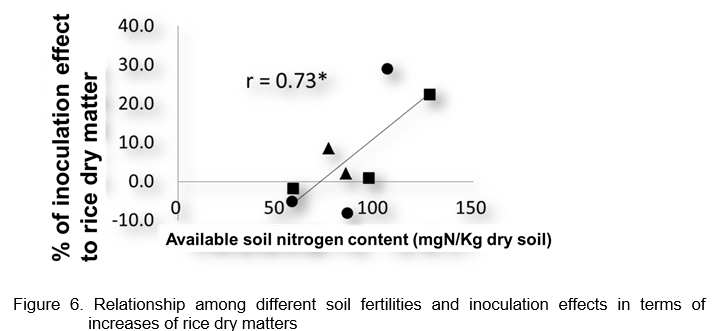
(iv) Factors of grain yield increase by inoculation of Bacillus pumilus TUAT1 to rice
When we applied spores of Bacillus pumilus TUAT1 to rice seedlings, we observed increases of rice grain yields at level of 10% to 30% in several field trials from 2014 to 2017. Figure 7 shows the results of positive inoculation effects in terms of increase of rice grain yields at paddy fields of Akita and Fukushima prefectures.
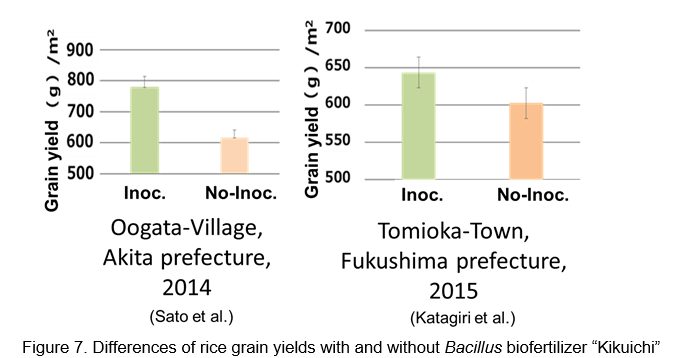
When Bacillus pumilus TUAT1 applies to rice seeds in nursery boxes, the seedlings show over 30% of increase of root growth such as root number and root weight of rice seedling against the control plants without TUAT1. When the rice plants with TUAT1 transplant to paddy fields, root growths of rice plants are keeping in paddy field with TUAT1, and rice plants expanding the root zone efficiently absorb nitrogen nutrients in the soil. As a result, the number of tillers of rice plants with biofertilizer increases. Since the expansion of the root zone provides a sufficient supply of nitrogen nutrients, the increased tillering becomes effective tillering, and the increase in the number of panicles ultimately increases the yield of brown rice by 10-30% as shown in Figure 8 (Khin Thuzar Win et al., 2018, 2019, 2021).
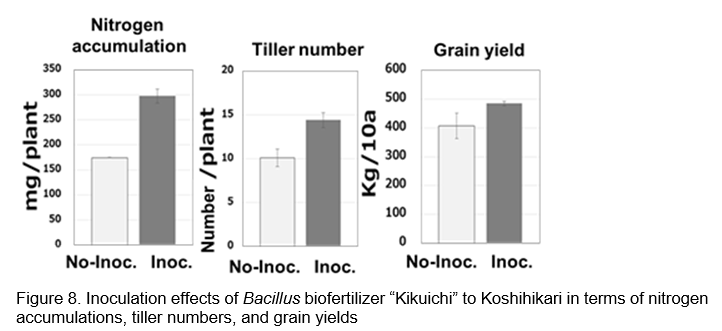
(v) Genomic characterization of Bacillus pumilus TUAT1
In our laboratory, we started to develop Bacillus biofertilizer focusing on Bacillus spores for paddy rice using Bacillus pumilus TUAT1 strain over 10 years ago. The whole genome of Bacillus pumilus TUAT1 has already been published (Okazaki and Yokoyama, 2019). The genome size is about 3.7 Mb, the GC content is 41.4%, the total number of genes is 3,850, and the whole genome is closest to the Bacillus pumilus MTCC B 6033 strain (Villanueva et al., 2014). More than 25 sporulation genes were present in the TUAT1 strain genomic sequence, and most of them were highly conserved within the Bacillus genus. Genes involved in plant growth promotion such as indole 3 acetic acid and siderophore synthesis were found in the TUAT1 strain genome sequence.


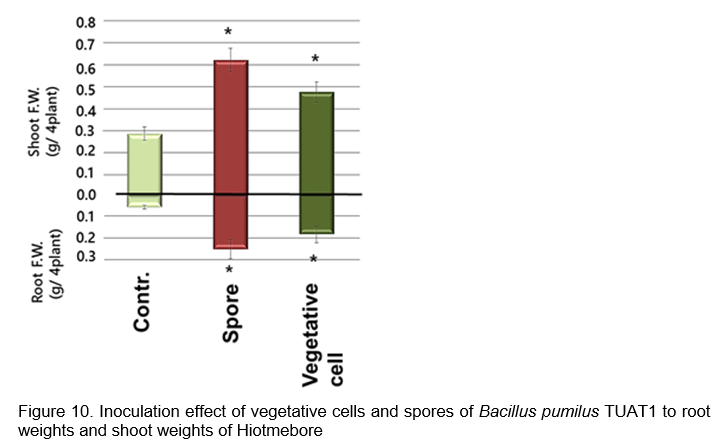
(vii) Differences in inoculation effect among rice cultivars inoculated with TUAT1 strain
In 'Koshihikari', 'Hitomebore', and 'Hinohikari', the inoculation effect of TUAT1 strain appeared stably. On the other hand, there are many cultivars throughout Japan, and there are also many groups in the world that are genetically different from Japanese rice. It was unclear whether the inoculation effect of the TUAT1 strain to promote root growth appeared equally in all the above rice plants. Therefore, using the root growth promoting effect as an evaluation criterion, we investigated how the root growth promotion changed when TUAT1 strain was inoculated into various rice lines shown in Figure 11.

The TUAT1 strain induced high rooting promotion for 'Koshihikari', which is the dominant variety in Japan, and 'Hitomebore', which is commonly cultivated in the Tohoku region. On the other hand, as for 'Takanari', rooting promotion was suppressed. As for other foreign lines, rooting was promoted in 6 lines from 'TUPA121-3' to 'JAGUARY', and rooting inhibition was observed in 3 lines from 'NERICA1' to 'Urasan No.1'. These results suggest that the TUAT1 strain has a high probability of inducing rooting in various rice lines.
(viii) Regarding rice inoculated with the TUAT1 strain and planted in paddy fields, where is the TUAT1 strain present in the rice roots?
TUAT1 strain infects roots at the time of emergence. Rice grown in seedling boxes is transplanted to paddy fields. It was unknown where the TUAT1 strain was present in the rice roots transplanted to the paddy field. Roots were cut into base, middle and tip parts, and the number of TUAT1 strains present in each tissue was examined.
TUAT1 strain was 104 cells/g of fresh weight (gFW) in most root samples immediately after transplantation. After that, it changed to 103 cells/gFW by 28 days after transplantation. From the results of 14 days and 28 days after transplantation, it was presumed that the TUAT1 strain was distributed intensively near the base of the root. As the root grows, the amount of TUAT1 cells detected at the base decreases. However, even 42 days after transplantation, bacterial cells were found to be distributed in the root base at the 103 level in 1 out of 4 roots samples. From these results, it was inferred that TUAT1 strain was distributed at the base of the root, and it was also presumed that responses such as promotion of rooting of rice were performed at that site.

(ix) Granule type of Bacillus biofertilizer “Kikuichi”
For the practical use of biofertilizers, we thought that biofertilizers should be used in the same way as chemical fertilizer. In addition, it was found that spores stably exert an inoculation effect, and it became possible to create granules using spores. Since 2011, Asahi Kogyo Co., Ltd., which specializes in formulating fertilizers, has participated, and started developing a new biofertilizer using zeolite material as a carrier for TUAT1 strain. Using the spores of the TUAT1 strain as a raw material, we developed a granular biofertilizer as a prototype for application in nursery boxes.
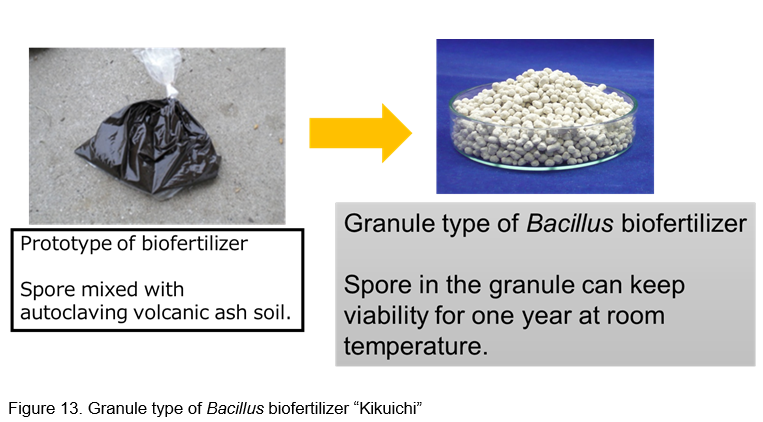
In agricultural practice shown in Figure 11, “Kikuichi” is applied at the level of 5% of nursery soil weight. And rice seeds are put on the “Kikuichi” in order to contact to “Kikuichi.” Then, those mixtures are covered by the nursery soils.
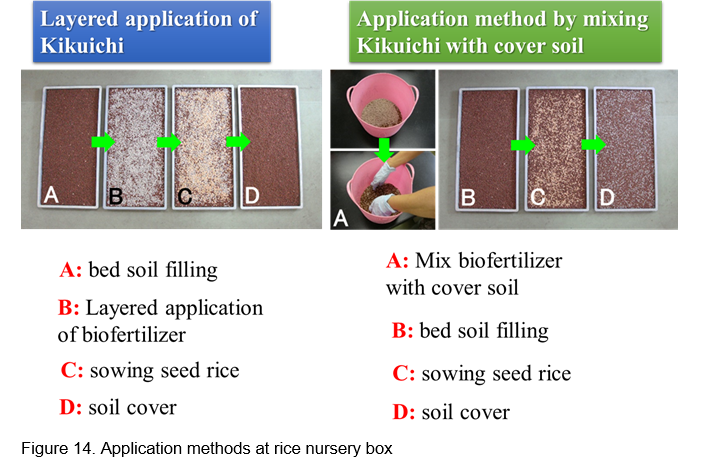
CONCLUSION
(Remaining issues: Mechanism of inducing rooting in rice by spores, etc.)
As a result of investigating the inoculation effect of live and dead spores of the TUAT1 strain of the Bacillus biofertilizer "Kikuichi", dead spore shells and their supernatants also showed a growth-promoting effect. Similarly, Bacillus spores from other species had similar effects (Ali et al., 2019).
The effects of biofertilizer microorganisms on crops are mainly to promote germination, rooting, increase the weight of above-ground parts and roots, increase yield, and promote nutrient absorption (Bashan et al., 2004; Mantelin et al., 2004; Bakker et al., 2007) have been reported. Gibberellins, cytokinins, and auxins produced by living microorganisms have been reported to be the factors that cause this. Similarly, the effects of plant hormones such as ACC deaminase and related enzymes have been shown to lower ethylene concentrations and reduce environmental stress (Gutiérrez-Mañero et al., 2001; Probanza et al., 2002; Glick et al., 2007).
It is presumed that the phenomenon of plant growth promoting effect induced by dead spores is a completely new response that cannot be explained by the principles based on living cells such as the production of plant hormones mentioned above. If we can clarify which substance in dead spores is the key substance for PGP activity, will living spores be no longer necessary for the inoculation effect of biofertilizers on rice? I think this verification is necessary.
REFERENCES
Ali Yawar Seerata, Taiichiro Ookawa, Katsuhiro Kojima, Naoko Ohkama-Ohtsu, Masumi Maeda, Salem Djedidi, Safiullah Habibi, Hitoshi Sekimoto, Akira Abe, Tadashi Yokoyama (2019) Evaluation of the effects of spores and their heat-treated residues from different Bacillus strains on the initial growth of rice plants. Soil Science and Plant Nutrition. 65:122-136 doi.org/10.1080/00380768.2018.1551042
Baldani V L and Döbereiner J (1980) Host-plant specificity in the infection of cereals with Azospirillum spp. Soil Biol. Biochem. 12, 433–439.
Chakraborty U, Chakraborty B, Basnet M (2006) Plant growth promotion and induction of resistance in Camellia sinensis by Bacillus megaterium. J Basic Microbiol 46 (3):186–195. doi: 10.1002/jobm.200510050
FNCA biofertilizer project https://www.fnca.mext.go.jp/english/bf/e_projectreview.html
Habibi S, Djedidi S, Prongjunthuek K, Mortuza MF, Ohkama-Ohtsu N, Sekimoto H, Yokoyama T (2014) Physiological and genetic characterization of rice nitrogen fixer PGPR isolated from rhizosphere soils of different crops. Plant Soil 379:51–66. doi: 10.1007/s11104-014-2035-7
Greenland DJ, Watanabe I (1982) The continuing nitrogen enigma. Trans 12th Int Congr Soil Sci, New Dehli: Whither Soil Research, Indian Soc Soil Sci, New Delhi, pp 125–137
Ladha J K et al. (1982) Immunological techniques to identify Azospirillum associated with wetland rice. Can. J. Microbiol. 28:478–485 doi: 10.1139/m82-073.
Okazaki, S., Naoto Sano, Tetsuya Yamada, Kazuo Ishii, Katsuhiro Kojima, Salem Djedidi, Maria D. Artigas Ramerez, Kun Yuan, Motoki Kanekatsu, Naoko Ohkama-Ohtsu, Yuu Hirose, Kenshiro Oshima, Masahira Hattori, Tadashi Yokoyam (2019) Complete Genome Sequence of Plant Growth-Promoting Bacillus pumilus TUAT1. Microbiol Resour. Announc.: e00076-19
Vessey JK (2003) Plant growth promoting rhizobacteria as biofertilizers. Plant and Soil 255 (2): 571–586. doi: 10.1023/a:1026037216893
Watanabe I, & C. Furusaka (1980) Microbial Ecology of Flooded Rice Soils. Advances in Microbial Ecology. pp125-168 DOI: 10.1007/978-1-4615-8291-5_4
Win Khin Thuzar, Keiki Okazaki, Taiichiro Ookawa, Tadashi Yokoyama, Yoshinari Ohwaki (2021) Effects of biochar and TUAT-1 bio-inoculant on grain yield and nitrogen efficiency of forage rice 'Monster rice 1' under different N application modes. Archives of Agronomy and Soil Science 68:1769-1783 doi.org/10.1080/03650340.2021.1928089
Win Khin Thuzar, Keiki Okazaki, Naoko Ohkama-Ohtsu, Tadashi Yokoyama, Yoshinari Ohwaki (2020) Short-term effects of biochar and Bacillus pumilus TUAT-1 on the growth of forage rice and its associated soil microbial community and soil properties. Biology and Fertility of Soils 56(4) 481-497 doi.org/10.1007/s00374-020-01448-x
Win KT, Okazaki K, Ookawa T, Yokoyama T, Ohwaki Y (2019) Effects of Thiosulfate as a Sulfur Source on Plant Growth, Metabolites Accumulation and Gene Expression in Arabidopsis and Rice. PLoS One. 14(7) e0220236 doi.org/10.1371/journal.pone.0220236
Yokoyama, T., Yamaya, H., Hosono, M., Todate, C., Ohtsu, N., Ookawa, T., Search for rice genetic factors that increase nutrient absorption capacity and grain yield in response to biofertilizer microorganisms(in Japanese). In “Research and development of security and safe crop production to reconstruct agricultural lands in Fukushima prefecture based on novel techniques to remove radioactive compounds using advanced bio-fertilizer and plant protection strategies”, edited by Yokoyama, T., TUAT (9906944), ISBN 978-4-9906944-3-2-3045- \00000E, p123-125, 2017.
Yokoyama, T., Yoshikawa, E., Ohtsu, N., Okazaki, S., Hosono, M., Todate, C., Ookawa, T., R/D of Bacillus biofertilzer for paddy rice and development of utilization technology in rice planting process (in Japanese). In “Research and development of security and safe crop production to reconstruct agricultural lands in Fukushima prefecture based on novel techniques to remove radioactive compounds using advanced bio-fertilizer and plant protection strategies”, edited by Yokoyama, T., TUAT (9906944), ISBN 978-4-9906944-3-2-3045- \00000E, p119-122, 2017.
Yoshida T., Rosabel R. Ancajas (1971) Nitrogen Fixation by Bacteria in the Root Zone of Rice. Soil Science Society of America Journal. 35:156-158 doi.org/10.2136/sssaj1971.03615995003500010047x
ACKNOWLEDGMENTS
This work is supported by the following funds.
1) MAFF Japan: Research and development projects for application in promoting new policy of Agriculture Forestry and Fisheries (No.26073C): Research and development of new rice cultivation technology using multi-functional biofertilizer in order to increase of grain yield under low fertilizer input condition (2014-2016).
2) NARO Japan: Project of the NARO Bio-oriented Technology Research Advancement Institution (the special scheme project on regional developing strategy) (No.C024): Empirical research on low-cost and high-grain yield production technology of feeding rice utilizing super high yield / high biomass rice varieties and biofertilizer under direct seeding cultivation of paddy rice for Fukushima agricultural revitalization (2016-2019).
3) Special research fund of MEXT Japan: “Research and development of security and safe crop production to reconstruct agricultural lands in Fukushima prefecture based on novel techniques to remove radioactive compounds using advanced bio-fertilizer and plant protection strategies.” (2012-2016)
Development of Bacillus biofertilizer “Kikuichi ©” and its Implementation in Agricultural Production Sites -Microbiological and Agricultural Characteristics-
DOI: https://doi.org/10.56669/GQOK7318
ABSTRACT
We developed Bacillus biofertilizer “Kikuichi” for paddy rice. This biofertilizer is a granule type, and spores of Bacillus pumilus TUAT1 are absorbed by the granule having base material of zeolite. Size of granule is around 3 mm and 107 spores are kept in one gram of granules. Quality of this biofertilizer can keep at least 1 year at room temperature. When Bacillus biofertilizer “Kikuichi” is applied to rice seeds in nursery boxes, the seedlings show over 30% of increase of root growth such as root number and root weight of rice seedlings against the control plants without “Kikuichi.” When the rice plants with “Kikuichi” are transplanted to paddy fields, root growths are keeping in paddy field and promote nitrogen fertilizer uptake. These inoculation effects induce an increase of tillers of treated rice plants, therefore, application of “Kikuichi” increase yields of brown rice at 10 to 30%. Rice plants applied with “Kikuichi” promote the efficiency of fertilizer utilization to develop root systems, therefore this property directly connects to reducing amounts of fertilizer application.
Keywords: Bacillus biofertilizer “Kikuichi”, Paddy rice, Bacillus pumilus TUAT1, Root growth promotion, Yield increase, Efficient fertilizer utilization
INTRODUCTION
There has been a history of research on nitrogen-fixing bacteria that provide nitrogen nutrients or growth-promoting effects for plants in loose symbiosis in the rhizosphere of rice and other crops. In 1971, Yoshida et al., (1971) reported the discovery of nitrogen-fixing activity in the rice rhizosphere. Watanabe and Furusaka (1980) also revealed that many nitrogen-fixing bacteria live in the rice rhizosphere. In addition, Baldani and Dobereiner (1980) and Ladha et al., (1982) isolated Azospirillum lipoferum and A. brasilense from rice roots. Greenland and Watanabe (1982) estimated biological nitrogen fixation in paddy fields to be 50-75 Kg N/ha based on the nitrogen balance of paddy fields in Japan and the Philippines with long-term fertilizer use.
Based on those studies, agricultural researchers in Southeast Asia inoculated rice plants with bacteria such as Azospirillum and conducted numerous field tests to determine whether the effect of the nitrogen-fixing activity could reduce the amount of chemical nitrogen fertilizer commonly used. (FNCA Biofertilizer Project, Choudhury I. R. Kennedy 2004). Figure 1 shows the growth of rice inoculated/uninoculated with Azospirillum. After about one month, the growth of rice in the inoculated plot has been promoted compared to the uninoculated one.
In Japan, biofertilizers contain root nodule bacteria and mycorrhizal fungi, as shown in Figure 2. Asian countries are conducting researches on using various soil microorganisms as biofertilizers. Biofertilizers have not been found in Japan include technology to inoculate rice, sugarcane, corn, etc. with non-symbiotic nitrogen-fixing bacteria to supply nitrogen nutrients, or phosphorus and to inoculate vegetables with potassium solubilizing bacteria to supply phosphorus and potassium. Figure 3 shows the Azospirillum biofertilizer for paddy rice used in Thailand and the liquid biofertilizer in Malaysia containing phosphorus-solubilizing and potassium-solubilizing bacteria launched in 2014.
However, these biofertilizers contain living microorganisms, and the number of active microorganisms in the material decreases due to temperature and drought stresses. This is a serious problem because the quality of the product cannot be guaranteed. Therefore, we focused on spore-forming nitrogen-fixing microorganisms. Furthermore, we took on the challenge of developing a completely new biofertilizer for paddy rice, which does not exist in the world market until now, with the same ease of use as chemical fertilizers, which means the quality of the product will last for at least one year.
DEVELOPMENT OF BACILLUS BIOFERTILIZER "KIKUICHI"
In Japan, the research and development of biofertilizers for paddy rice with the aim of reducing the amounts of chemical fertilizers applied has hardly been carried out. There are many inoculation tests using Azospirillum bacteria in the world. However, quality control of Azospirillum bacteria is very difficult. On the other hand, there is no research on inoculants for paddy rice using bacteria of the genus Bacillus. In addition, Bacillus bacteria form spores and have high survivability even in high temperature and drought stress environments during both transportation and storage of biofertilizers.
Therefore, Bacillus pumilus TUAT1 strain was isolated from the field soil of Tokyo University of Agriculture and Technology (TUAT). It has been found that this strain has nitrogen-fixing ability and promotes rooting of rice. Figure 4 shows a photograph of colonies of Bacillus pumilus TUAT1 strain on TY medium.
(i) Growth promoting effect of rice inoculated with TUAT1 strain (Evaluation tests in greenhouses and fields)
A pot test was started in 2008. We started testing the TUAT1 strain without knowing the optimal inoculation method. Therefore, the TUAT1 strain was cultured, the bacteria were collected with a centrifuge, and then mixed with steam sterilized Kuroboku soil from the Fuchu farm of TUAT. Bacteria density was set to 107 to 108 cells per gram of soil. The rice cultivar Leaf Star was used, and the test plots were conventionally fertilized plots (NPK 5kg/10a each), plots with 60% less nitrogen fertilizer applied, and non-fertilization plots, each of which was inoculated and non-inoculated. Inoculation was carried out by wrapping the roots at the time of transplantation with 200 g of the above inoculum. The measured items were the dry weight of each part, the accumulation of N, P, and K in the plant body, and the contribution rate of nitrogen fixation by the TUAT1 strain, which was estimated by the 15N natural abundance method.
The dry matter weight of the roots in inoculated plots of the conventional fertilization plots was about twice that of non-inoculated plots, indicating that inoculation greatly accelerates the development of roots. In addition, the accumulation of NPK in inoculated plots were promoted more compared with non-inoculated ones. Root development in the 60% reduced fertilizer plot was greater than that of non-inoculated conventional plot (data not shown).
Since the pot test in 2008 has clearly shown the inoculation effect of TUAT1 strain, a field test was conducted in 2009 in the Field Museum Honmachi paddy field (gravely ordinary gray lowland soil) of the Field Science Center in TUAT. As in 2008, 'Leaf Star' was used for rice cultivar. The test plots were a conventional fertilization plot (NPK10kg/10a), a 30% nitrogen fertilizer reduction plot, and a non-fertilization plot, and a bacteria inoculation plot and a non-inoculation plot were established for each. As for the bacterial inoculation method, 100 g of the above inoculum was suspended in water, and the roots at the time of transplanting were soaked about 15 minutes for inoculation. The measurement items were the dry weight of above-ground parts, the accumulation of N, P, and K in the plant body, and the 15N natural abundance method.
In the conventionally fertilized plot, the total dry matter weight of the inoculated plot increased by about 21% compared to the non-inoculated plot. Nitrogen accumulation in the inoculated plot of the conventional fertilization plot increased by 37% compared to the non-inoculated plot, and P and K accumulation also increased by 29%, respectively. On the other hand, in the 30% nitrogen-reduced plot, the total dry weight of the inoculated plot was 92% of that of the conventional non-inoculated plot. In addition, in the conventional fertilization plot and the 30% nitrogen fertilizer reduction plot, nutrient absorption and growth were clearly promoted in the inoculated plot compared to the non-inoculated plot (data not shown).
The results of 2008 pot experiments and 2009 field experiments showed that inoculation with the Bacillus biofertilizer increased dry matter accumulation and NPK accumulation in Leaf Star. In addition, it was presumed that the enhancement of nitrogen uptake in rice was due to the development of the root system by bacterial inoculation, which efficiently absorbed mineralized nitrogen in the soil and fertilized nitrogen. In the field test, about 30% of nitrogen reduction treatment with biofertilizer was observed to promote rice growth, compensating for growth by more than 90% of the conventionally fertilized plot without biofertilizer.
(ii) Estimation of the contribution of biological nitrogen fixation to total nitrogen in rice inoculated with Bacillis biofertilizer by measuring δ15N values
TUAT1 strain was found to have nitrogen-fixing activity by examining with acetylene reduction method (Habibi et al., 2014). Therefore, it is necessary to investigate whether the nitrogen-fixing ability of the TUAT1 strain contributes to nitrogen supply to rice. In the 2008 pot experiment and the 2009 field experiment, δ15N values of rice plants were measured.
The mass of nitrogen atoms in plants that have taken up ammonia produced by biological nitrogen fixation or industrial nitrogen fixation approaches the mass of atmospheric nitrogen atoms, 14N, and becomes lighter. On the other hand, the mass of nitrogen atoms in ammonia mineralized from organic matter in the soil approaches 15N and becomes heavy. Based on this idea, the contribution of biological nitrogen fixation to nitrogen nutrients acquired by plants can be estimated by comparing the δ15N values of nitrogen atoms in plant bodies in both the inoculated and non-inoculated plots. In the 2008 pot test, when looking at the Bacillus biofertilizer-inoculated and non-inoculated plots in the no-fertilization plot and the conventional fertilization plot, the δ15N value was larger in the inoculated plot. Also, in the field test in 2009, the value of the inoculated plot was larger (data not shown). From these results, it was suggested that the Bacillus biofertilizer-inoculated plot did not take in air-fixed nitrogen, but rather promoted the absorption of mineralized nitrogen in the soil.
(iii) Relationship between soil fertility and inoculation effect
After 2011, full-scale field tests were started in the paddy fields of the TUAT, but the inoculation effect was not stable. Therefore, in order to clarify the reason, the amount of available nitrogen in the paddy field used was investigated in detail. As a result, as shown in Fig. 5, it was found that the amount of available nitrogen supply was uneven in the experimental paddy field.
'Koshihikari' seedlings inoculated with TUAT1 strain and uninoculated 'Koshihikari' seedlings were transplanted and cultivated for each plot in Fig. 5, and the dry weight of rice in each plot was measured to evaluate the inoculation effect. As described in Fig. 6, the inoculation effect of Bacillus biofertilizer increased with increasing soil available nitrogen supply. From this, a positive correlation was found between the inoculation effect of Bacillus biofertilizer and the amount of available nitrogen supply in the soil. From these results, it was found that this biofertilizer has a remarkable inoculation effect on soil with high soil fertility.
(iv) Factors of grain yield increase by inoculation of Bacillus pumilus TUAT1 to rice
When we applied spores of Bacillus pumilus TUAT1 to rice seedlings, we observed increases of rice grain yields at level of 10% to 30% in several field trials from 2014 to 2017. Figure 7 shows the results of positive inoculation effects in terms of increase of rice grain yields at paddy fields of Akita and Fukushima prefectures.
When Bacillus pumilus TUAT1 applies to rice seeds in nursery boxes, the seedlings show over 30% of increase of root growth such as root number and root weight of rice seedling against the control plants without TUAT1. When the rice plants with TUAT1 transplant to paddy fields, root growths of rice plants are keeping in paddy field with TUAT1, and rice plants expanding the root zone efficiently absorb nitrogen nutrients in the soil. As a result, the number of tillers of rice plants with biofertilizer increases. Since the expansion of the root zone provides a sufficient supply of nitrogen nutrients, the increased tillering becomes effective tillering, and the increase in the number of panicles ultimately increases the yield of brown rice by 10-30% as shown in Figure 8 (Khin Thuzar Win et al., 2018, 2019, 2021).
(v) Genomic characterization of Bacillus pumilus TUAT1
In our laboratory, we started to develop Bacillus biofertilizer focusing on Bacillus spores for paddy rice using Bacillus pumilus TUAT1 strain over 10 years ago. The whole genome of Bacillus pumilus TUAT1 has already been published (Okazaki and Yokoyama, 2019). The genome size is about 3.7 Mb, the GC content is 41.4%, the total number of genes is 3,850, and the whole genome is closest to the Bacillus pumilus MTCC B 6033 strain (Villanueva et al., 2014). More than 25 sporulation genes were present in the TUAT1 strain genomic sequence, and most of them were highly conserved within the Bacillus genus. Genes involved in plant growth promotion such as indole 3 acetic acid and siderophore synthesis were found in the TUAT1 strain genome sequence.
(vii) Differences in inoculation effect among rice cultivars inoculated with TUAT1 strain
In 'Koshihikari', 'Hitomebore', and 'Hinohikari', the inoculation effect of TUAT1 strain appeared stably. On the other hand, there are many cultivars throughout Japan, and there are also many groups in the world that are genetically different from Japanese rice. It was unclear whether the inoculation effect of the TUAT1 strain to promote root growth appeared equally in all the above rice plants. Therefore, using the root growth promoting effect as an evaluation criterion, we investigated how the root growth promotion changed when TUAT1 strain was inoculated into various rice lines shown in Figure 11.
The TUAT1 strain induced high rooting promotion for 'Koshihikari', which is the dominant variety in Japan, and 'Hitomebore', which is commonly cultivated in the Tohoku region. On the other hand, as for 'Takanari', rooting promotion was suppressed. As for other foreign lines, rooting was promoted in 6 lines from 'TUPA121-3' to 'JAGUARY', and rooting inhibition was observed in 3 lines from 'NERICA1' to 'Urasan No.1'. These results suggest that the TUAT1 strain has a high probability of inducing rooting in various rice lines.
(viii) Regarding rice inoculated with the TUAT1 strain and planted in paddy fields, where is the TUAT1 strain present in the rice roots?
TUAT1 strain infects roots at the time of emergence. Rice grown in seedling boxes is transplanted to paddy fields. It was unknown where the TUAT1 strain was present in the rice roots transplanted to the paddy field. Roots were cut into base, middle and tip parts, and the number of TUAT1 strains present in each tissue was examined.
TUAT1 strain was 104 cells/g of fresh weight (gFW) in most root samples immediately after transplantation. After that, it changed to 103 cells/gFW by 28 days after transplantation. From the results of 14 days and 28 days after transplantation, it was presumed that the TUAT1 strain was distributed intensively near the base of the root. As the root grows, the amount of TUAT1 cells detected at the base decreases. However, even 42 days after transplantation, bacterial cells were found to be distributed in the root base at the 103 level in 1 out of 4 roots samples. From these results, it was inferred that TUAT1 strain was distributed at the base of the root, and it was also presumed that responses such as promotion of rooting of rice were performed at that site.
(ix) Granule type of Bacillus biofertilizer “Kikuichi”
For the practical use of biofertilizers, we thought that biofertilizers should be used in the same way as chemical fertilizer. In addition, it was found that spores stably exert an inoculation effect, and it became possible to create granules using spores. Since 2011, Asahi Kogyo Co., Ltd., which specializes in formulating fertilizers, has participated, and started developing a new biofertilizer using zeolite material as a carrier for TUAT1 strain. Using the spores of the TUAT1 strain as a raw material, we developed a granular biofertilizer as a prototype for application in nursery boxes.
In agricultural practice shown in Figure 11, “Kikuichi” is applied at the level of 5% of nursery soil weight. And rice seeds are put on the “Kikuichi” in order to contact to “Kikuichi.” Then, those mixtures are covered by the nursery soils.
CONCLUSION
(Remaining issues: Mechanism of inducing rooting in rice by spores, etc.)
As a result of investigating the inoculation effect of live and dead spores of the TUAT1 strain of the Bacillus biofertilizer "Kikuichi", dead spore shells and their supernatants also showed a growth-promoting effect. Similarly, Bacillus spores from other species had similar effects (Ali et al., 2019).
The effects of biofertilizer microorganisms on crops are mainly to promote germination, rooting, increase the weight of above-ground parts and roots, increase yield, and promote nutrient absorption (Bashan et al., 2004; Mantelin et al., 2004; Bakker et al., 2007) have been reported. Gibberellins, cytokinins, and auxins produced by living microorganisms have been reported to be the factors that cause this. Similarly, the effects of plant hormones such as ACC deaminase and related enzymes have been shown to lower ethylene concentrations and reduce environmental stress (Gutiérrez-Mañero et al., 2001; Probanza et al., 2002; Glick et al., 2007).
It is presumed that the phenomenon of plant growth promoting effect induced by dead spores is a completely new response that cannot be explained by the principles based on living cells such as the production of plant hormones mentioned above. If we can clarify which substance in dead spores is the key substance for PGP activity, will living spores be no longer necessary for the inoculation effect of biofertilizers on rice? I think this verification is necessary.
REFERENCES
Ali Yawar Seerata, Taiichiro Ookawa, Katsuhiro Kojima, Naoko Ohkama-Ohtsu, Masumi Maeda, Salem Djedidi, Safiullah Habibi, Hitoshi Sekimoto, Akira Abe, Tadashi Yokoyama (2019) Evaluation of the effects of spores and their heat-treated residues from different Bacillus strains on the initial growth of rice plants. Soil Science and Plant Nutrition. 65:122-136 doi.org/10.1080/00380768.2018.1551042
Baldani V L and Döbereiner J (1980) Host-plant specificity in the infection of cereals with Azospirillum spp. Soil Biol. Biochem. 12, 433–439.
Chakraborty U, Chakraborty B, Basnet M (2006) Plant growth promotion and induction of resistance in Camellia sinensis by Bacillus megaterium. J Basic Microbiol 46 (3):186–195. doi: 10.1002/jobm.200510050
FNCA biofertilizer project https://www.fnca.mext.go.jp/english/bf/e_projectreview.html
Habibi S, Djedidi S, Prongjunthuek K, Mortuza MF, Ohkama-Ohtsu N, Sekimoto H, Yokoyama T (2014) Physiological and genetic characterization of rice nitrogen fixer PGPR isolated from rhizosphere soils of different crops. Plant Soil 379:51–66. doi: 10.1007/s11104-014-2035-7
Greenland DJ, Watanabe I (1982) The continuing nitrogen enigma. Trans 12th Int Congr Soil Sci, New Dehli: Whither Soil Research, Indian Soc Soil Sci, New Delhi, pp 125–137
Ladha J K et al. (1982) Immunological techniques to identify Azospirillum associated with wetland rice. Can. J. Microbiol. 28:478–485 doi: 10.1139/m82-073.
Okazaki, S., Naoto Sano, Tetsuya Yamada, Kazuo Ishii, Katsuhiro Kojima, Salem Djedidi, Maria D. Artigas Ramerez, Kun Yuan, Motoki Kanekatsu, Naoko Ohkama-Ohtsu, Yuu Hirose, Kenshiro Oshima, Masahira Hattori, Tadashi Yokoyam (2019) Complete Genome Sequence of Plant Growth-Promoting Bacillus pumilus TUAT1. Microbiol Resour. Announc.: e00076-19
Vessey JK (2003) Plant growth promoting rhizobacteria as biofertilizers. Plant and Soil 255 (2): 571–586. doi: 10.1023/a:1026037216893
Watanabe I, & C. Furusaka (1980) Microbial Ecology of Flooded Rice Soils. Advances in Microbial Ecology. pp125-168 DOI: 10.1007/978-1-4615-8291-5_4
Win Khin Thuzar, Keiki Okazaki, Taiichiro Ookawa, Tadashi Yokoyama, Yoshinari Ohwaki (2021) Effects of biochar and TUAT-1 bio-inoculant on grain yield and nitrogen efficiency of forage rice 'Monster rice 1' under different N application modes. Archives of Agronomy and Soil Science 68:1769-1783 doi.org/10.1080/03650340.2021.1928089
Win Khin Thuzar, Keiki Okazaki, Naoko Ohkama-Ohtsu, Tadashi Yokoyama, Yoshinari Ohwaki (2020) Short-term effects of biochar and Bacillus pumilus TUAT-1 on the growth of forage rice and its associated soil microbial community and soil properties. Biology and Fertility of Soils 56(4) 481-497 doi.org/10.1007/s00374-020-01448-x
Win KT, Okazaki K, Ookawa T, Yokoyama T, Ohwaki Y (2019) Effects of Thiosulfate as a Sulfur Source on Plant Growth, Metabolites Accumulation and Gene Expression in Arabidopsis and Rice. PLoS One. 14(7) e0220236 doi.org/10.1371/journal.pone.0220236
Yokoyama, T., Yamaya, H., Hosono, M., Todate, C., Ohtsu, N., Ookawa, T., Search for rice genetic factors that increase nutrient absorption capacity and grain yield in response to biofertilizer microorganisms(in Japanese). In “Research and development of security and safe crop production to reconstruct agricultural lands in Fukushima prefecture based on novel techniques to remove radioactive compounds using advanced bio-fertilizer and plant protection strategies”, edited by Yokoyama, T., TUAT (9906944), ISBN 978-4-9906944-3-2-3045- \00000E, p123-125, 2017.
Yokoyama, T., Yoshikawa, E., Ohtsu, N., Okazaki, S., Hosono, M., Todate, C., Ookawa, T., R/D of Bacillus biofertilzer for paddy rice and development of utilization technology in rice planting process (in Japanese). In “Research and development of security and safe crop production to reconstruct agricultural lands in Fukushima prefecture based on novel techniques to remove radioactive compounds using advanced bio-fertilizer and plant protection strategies”, edited by Yokoyama, T., TUAT (9906944), ISBN 978-4-9906944-3-2-3045- \00000E, p119-122, 2017.
Yoshida T., Rosabel R. Ancajas (1971) Nitrogen Fixation by Bacteria in the Root Zone of Rice. Soil Science Society of America Journal. 35:156-158 doi.org/10.2136/sssaj1971.03615995003500010047x
ACKNOWLEDGMENTS
This work is supported by the following funds.
1) MAFF Japan: Research and development projects for application in promoting new policy of Agriculture Forestry and Fisheries (No.26073C): Research and development of new rice cultivation technology using multi-functional biofertilizer in order to increase of grain yield under low fertilizer input condition (2014-2016).
2) NARO Japan: Project of the NARO Bio-oriented Technology Research Advancement Institution (the special scheme project on regional developing strategy) (No.C024): Empirical research on low-cost and high-grain yield production technology of feeding rice utilizing super high yield / high biomass rice varieties and biofertilizer under direct seeding cultivation of paddy rice for Fukushima agricultural revitalization (2016-2019).
3) Special research fund of MEXT Japan: “Research and development of security and safe crop production to reconstruct agricultural lands in Fukushima prefecture based on novel techniques to remove radioactive compounds using advanced bio-fertilizer and plant protection strategies.” (2012-2016)